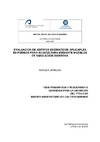Please use this identifier to cite or link to this item:
https://accedacris.ulpgc.es/jspui/handle/10553/74697
| DC Field | Value | Language |
|---|---|---|
| dc.contributor.advisor | Moyano López, Francisco Javier | es |
| dc.contributor.advisor | Montero Vítores, Daniel | es |
| dc.contributor.author | Bainour, Khalida | es |
| dc.date.accessioned | 2020-10-13T12:10:22Z | - |
| dc.date.available | 2020-10-13T12:10:22Z | - |
| dc.date.issued | 2020 | - |
| dc.identifier.uri | https://accedacris.ulpgc.es/handle/10553/74697 | - |
| dc.description.abstract | Una prioridad actual en la industria de la acuicultura es el reemplazo de la harina de pescado con piensos alternativos, incluidos los ingredientes de proteínas de origen vegetal, para garantizar su sostenibilidad (Castillo y Gatlin, 2015). Sin embargo, la mayoría de los alimentos de origen vegetal tienen una amplia variedad de factores antinutricionales (principalmente fitato y polisacáridos no amiláceos (PNA)) que pueden afectar la utilización de nutrientes, el rendimiento y la salud de los peces (Francis et al., 2001; NRC, 2011). Para contrarrestar los potenciales efectos negativos se ha evaluado la adición de mezclas enzimáticas. En este estudio, se diseñaron dos experimentos diferentes. El experimento 1 evaluó el efecto de un pretratamiento de ingredientes vegetales incluidos en un alimento para una especie piscícola marina de hábito herbívoro-omnívoro (mújol), y otro de habito carnívoro (lubina), con diferentes aditivos enzimáticos comerciales basados en glucanasas y fitasas, sobre la biodisponibilidad potencial de PNA y fitato. El ensayo utilizó un diseño factorial completo para determinar la combinación óptima de los factores seleccionados cuando se usa en un proceso de SSH (hidrólisis de estado sólido): tiempo de incubación, dosis y humedad de la mezcla. El experimento 2 utilizó una simulación in vitro de la digestión de los peces para evaluar las posibles diferencias en la biodisponibilidad de nutrientes cuando la mezcla de enzimas se agregó de dos maneras posibles; ya sea utilizando el tratamiento previo mencionado o directamente incluido en el alimento y procesado. Los resultados mostraron que en este último caso la enzima no superó las temperaturas utilizadas durante la elaboración de los alimentos, lo que apunta a la idoneidad de usarlos como el pretratamiento indicado. | en_US |
| dc.description.abstract | A current priority in the aquaculture industry is the replacement of fishmeal with alternative feedstuffs, including plant-based protein ingredients, to ensure its sustainability (Castillo y Gatlin, 2015). However, most plant-based feedstuffs have a wide variety of anti-nutritional factors such as phytin, non-starch polysaccharides (PNA) and protease inhibitors, which may impair nutrient utilization, as well as impair fish performance and health (Francis et al., 2001; NRC, 2011). To counteract these potential negative effects, the addition of enzymatic mixtures has been evaluated. In this study, two different experiments were designed. Experiment 1 evaluated the effect of a pre-treatment of plant ingredients included in a feed for a marine fish species with an herbivorous-omnivorous habit (mullet), and another with a carnivorous habit (sea bass), with different commercial enzyme additives based on glucanases and phytase, on the potential bioavailability of PNA and phytate. The assay used a full factorial design to determine the optimal combination of the selected factors when used in a process of SSH (Solid State Hydrolysis): incubation time, dose and moisture of the mixture. Experiment 2 used an in vitro simulation of the digestion of the fish to assess potential differences in bioavailability of nutrients when the enzyme mixture was added in two possible ways; either using the aforementioned pretreatment or directly included in the feed and processed. Results showed that in this latter case the enzyme did not overcome temperatures used during elaboration of the feeds, this pointing to the suitability of using them as the indicated pretreatment. | en_US |
| dc.language | spa | en_US |
| dc.subject | 251092 Acuicultura marina | en_US |
| dc.subject.other | Modelización digestiva | es |
| dc.title | Evaluación de aditivos enzimáticos aplicables en piensos para acuicultura mediante modelos de simulación digestiva | es |
| dc.type | info:eu-repo/semantics/masterThesis | en_US |
| dc.type | MasterThesis | en_US |
| dc.contributor.facultad | Facultad de Ciencias del Mar | en_US |
| dc.investigacion | Ciencias | en_US |
| dc.type2 | Trabajo final de máster | en_US |
| dc.description.notas | Máster Universitario en Cultivos Marinos ; 2018-2020. Diploma de Master of Science en Acuicultura otorgado por el Centro Internacional de Altos Estudios Agronómicos Mediterráneos (CIHEAM) | en_US |
| dc.utils.revision | Sí | en_US |
| dc.identifier.matricula | TFT-57270 | es |
| dc.identifier.ulpgc | Sí | en_US |
| dc.contributor.buulpgc | BU-BAS | es |
| dc.contributor.titulacion | Máster Universitario en Cultivos Marinos | es |
| item.grantfulltext | restricted | - |
| item.fulltext | Con texto completo | - |
| crisitem.author.fullName | Bainour, Khalida | - |
| crisitem.advisor.dept | GIR Grupo de Investigación en Acuicultura | - |
| crisitem.advisor.dept | IU de Investigación en Acuicultura Sostenible y Ec | - |
| crisitem.advisor.dept | Departamento de Biología | - |
| Appears in Collections: | Trabajo final de máster Restringido ULPGC | |
Page view(s)
278
checked on Jan 27, 2024
Download(s)
59
checked on Jan 27, 2024
Google ScholarTM
Check
Share
Export metadata
Items in accedaCRIS are protected by copyright, with all rights reserved, unless otherwise indicated.
